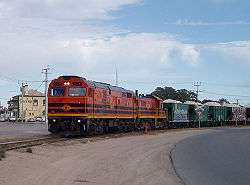Railways in Adelaide

The rail network in Adelaide, South Australia, consists of six lines and 81 stations, totalling 125.9 km. It is operated by Adelaide Metro, and is part of the city-wide Adelaide Metro public transport system.
All lines around Adelaide were originally broad gauge 1,600 mm (5 ft 3 in). The main interstate lines out of Adelaide towards Melbourne, Sydney, Perth and Darwin have been progressively converted to standard gauge 1,435 mm (4 ft 8 1⁄2 in), but the suburban system and a few freight-only branch lines to the north remain broad gauge.
Operators
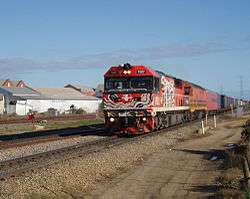

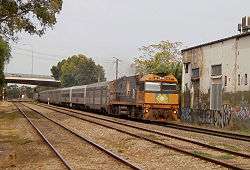
Rail services around Adelaide are provided by a mixture of private & government-owned organisations.
The Department Of Planning, Transport and Infrastructure owns and operates the suburban passenger rail network. This comprises five lines from Adelaide railway station on North Terrace in the CBD. The Department Of Planning, Transport and Infrastructure also owns and operates the Glenelg Tram. Adelaide's Tram Network is the only fully Government owned and operated tram network in Australia.
ARTC (Australian Rail Track Corporation), an agency of the Australian federal government, owns standard gauge interstate lines heading north and south, together with the dual gauge freight-only branch from Dry Creek to Port Adelaide and Pelican Point. The ARTC lines bypass the city to the west and do not enter the CBD. The ARTC network extends from Adelaide towards Melbourne, Sydney, Perth and Darwin and is used by substantial interstate freight traffic.
Freight trains are operated by a number of private operators, who have access agreements with rail network owners such as ARTC. The largest of these is Pacific National, which handles the majority of interstate traffic and has the largest locomotive fleet. Other logistics companies also operate freight trains to and from interstate destinations and within South Australia.
Australian Railroad Group (ARG) is a private consortium that owns the remaining broad-gauge lines beyond the Adelaide suburban network. These are a handful of lines used mainly to move bulk grain and stone from the Barossa Valley and mid-north region of S.A. to the Port Adelaide area. ARG also operates standard-gauge branches to Apamurra, Loxton and Pinnaroo (all in the Murray Mallee east of Adelaide) and an isolated narrow-gauge line from Port Lincoln into Eyre Peninsula. These transport seasonal grain traffic to ports for export.
Great Southern Rail (GSR) is a private company operating long-distance passenger trains on ARTC’s standard gauge lines, and run from the Adelaide Parklands Terminal (formerly Keswick Rail Terminal), not from the main city station - Keswick is an industrial suburb just west of the CBD. GSR’s trains are the Indian Pacific to Sydney and Perth, The Ghan to Alice Springs and Darwin and The Overland to Melbourne. The frequencies range from one to four trains per week. There have been no intrastate regional passenger services in South Australia since 1990.
There are several heritage railways in South Australia run by volunteers, but none of these are in the Adelaide area. The closest is SteamRanger at Mount Barker and Goolwa. A more distant line, well outside the Adelaide area, is the Pichi Richi Railway.
History
Early days
In 1856, the first steam train ran between Adelaide and Port Adelaide, stopping at Bowden, Woodville and Alberton.[1] Soon after, a 40 km line was built from the Town of Gawler to Adelaide to cater for the agricultural and mining industries.
The South Line, through the Adelaide Hills, opened to Aldgate, then Nairne in 1883, and extended to Bordertown in 1886. The first through train between Adelaide and Melbourne – The Intercolonial Express – ran on 19 January 1887, and was the first intercapital rail journey in Australia without changing trains at a break-of-gauge station.
Most of the lines around Adelaide were built before 1900.
The Webb Era
Despite the earlier geographic expansion, by 1920 the infrastructure and rolling stock of South Australia's railways (SAR) had become run down, inadequate and outdated. Many of the operating practices, such as train control and signalling, were backward by the standards of the time.
However the 1920s saw substantial and expensive improvements in most facets of the SAR’s operations under the leadership of Railways Commissioner William A. Webb. Webb was an American who had substantial operational experience with US railroads, and served as Commissioner between 1922 and 1930.
During his reign, track, bridges, railway workshops, rolling stock and especially steam locomotives were all modernised and upgraded along essentially American lines. Adelaide Station was rebuilt with a handsome sandstone building as a showpiece of the city on North Terrace. The building still stands; the lower level remains as the railway station, but the upper levels have been converted into a casino.
In 1929, one of the original broad-gauge steam railways to the beach-side suburb of Glenelg was transferred to the Adelaide Municipal Tramways Trust, electrified and converted to a tramway. The Glenelg Tram line is still in operation.
SAR, STA and AN
From early colonial days up until 1978 the SAR had built and operated most of the railway system within the state.
The Commonwealth Railways (CR), owned by the Federal Government, also had a significant role in the northern part of SA, with lines from Port Augusta across the Nullarbor to Kalgoorlie, and to Marree and Alice Springs. None of its lines came close to Adelaide.
During the early 1970s the Labor-controlled Federal Government proposed a strategy to nationalise and standardise the various state rail systems around Australia. South Australia and Tasmania were the only states to participate in this initiative and negotiations were long and drawn out. The result was that in March 1978 the SAR became defunct and South Australia’s railways were split between Commonwealth and State Government ownership.
A new Commonwealth Government organisation, Australian National Railways Commission (ANR), took over all the former SAR and CR track in South Australia outside the metropolitan area. Other rail facilities such as property and workshops were also transferred to ANR. ANR become Australian National (AN) as it refined its corporate identity.
The State Government retained ownership and control of tracks and trains in the Adelaide suburban area under the auspices of the State Transport Authority (STA). The STA had been created in 1974 to co-ordinate all public transport in South Australia.
In 1994 the STA was abolished and reformed as the government-owned corporate body TransAdelaide as a prelude to competitive tendering for operation of bus and rail services in metropolitan Adelaide. TransAdelaide subsequently lost all its bus services to private operators, but has retained the contracts to operate train and tram services.
In November 1997, AN was broken up and sold as part of a Federal Government privatisation agenda. Track, workshops, depots and passenger & freight operations were sold to various private organizations, which has led to today’s operational structure described in an earlier section.
Modern day
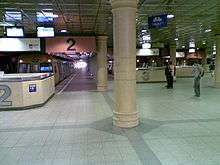
Adelaide's metropolitan rail services are operated by The Department of Planning, Transport and Infrastructure, Public Transport Services Division and run under the Adelaide Metro brand, (formerly TransAdelaide), and the network is the last in mainland Australia to be electrified at 25 kV AC. Funding was provided in the 2008-09 State Budget to commence a ten-year electrification and track upgrade project, with $245 million to start work on the Outer Harbor rail line and $209.7 million for the Noarlunga line.[2] The AUS$2 billion program will deliver 50 new electric trains, 58 existing trains converted for electric use, 15 hybrid tram/trains.[3]
In the 2009 Federal Budget, following negotiations between Prime Minister Kevin Rudd and Premier Mike Rann, Federal Treasurer Wayne Swan announced $650 million would be provided from the Infrastructure Fund to upgrade rail services in Adelaide. The commitment included $294 million to co-fund, with the SA government, the electrification of the Gawler line, and $291 million to extend the Noarlunga line to Seaford. The development included building a bridge, one of the nation’s longest, over the Onkaparinga River.[4]
During much of 2013, the Seaford and Tonsley rail lines have been closed to enable the modernisation to be progressed.[5]
The six railway lines (all broad gauge) making up the suburban network are:
Belair Line (21.5 km):
- Adelaide to Bridgewater built in 1883
- Belair to Bridgewater closed 1987
- Adelaide to Melbourne via Belair and Bridgewater was converted to standard gauge in 1995, leaving one broad-gauge track from Goodwood to Belair - 21.5 km
Gawler Central Line (42.2 km):
- Adelaide to Gawler Central built in 1857
Grange Line (5.5 km):
Outer Harbor Line (21.9 km):
- Adelaide to Port Adelaide built in 1856 - 11.7 km
- Glanville to Outer Harbor built in 1908 - 10.2 km
Seaford Line (36.0 km):
- Goodwood to Marino built in 1913 - 18.3 km
- Marino to Hallett Cove built in 1915 - 3.1 km
- Lonsdale to Christie Downs built in 1976 - 2.2 km
- Christie Downs to Noarlunga built in 1978 - 1.3 km
- Noarlunga to Seaford opened in February 2014 - 5.8 km
Tonsley Line (3.9 km):
- Woodlands Park to Tonsley built in 1966 - 3.9 km
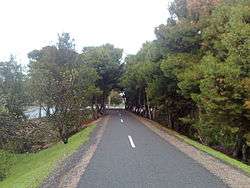
Adelaide's rail network has decreased in size since the 1950s, with the closure of several lines, branches and stations, including:
- Henley Beach line: from Grange to Henley Beach built in 1894 (closed and dismantled in 1957)
- Willunga line: from Hallett Cove to Willunga built in 1915 (closed in 1969). This is now the Coast to Vines Rail Trail.
- Penfield line: from Salisbury to Penfield 3 built in 1941 (closed and dismantled in 1991)
- Northfield line: from Adelaide to Norhfield built in 1857 (closed in 1987)
- Semaphore line: from Port Adelaide to Semaphore built in 1878 (closed and dismantled in 1978, to be rebuilt ~2018)
- Dry Creek-Port Adelaide line: Currently able to operate as dual-gauge freight, the last suburban passenger services ran on the line in 1988.
Current rolling stock
- 30 3000 class railcars built by Commonwealth Engineering and Clyde Engineering, 1988-1996
- 40 3100 class railcars built by Commonwealth Engineering and Clyde Engineering, 1988-1996
- 22 A-City Class 4000 Electric Multiple Units built by Bombardier Transportation
See also
Adelaide Railway
- List of Adelaide railway stations
- List of closed Adelaide railway stations
- List of public transport routes in Adelaide
- Redhen railcar
- 2000 class railcar
- Glenelg Tram
- 3000 class railcar
Adelaide
South Australia
Australia
Worldwide
References and notes
- ↑ The Adelaide, City and Port Railway Callaghan, W.H. Australian Railway History, April/May, 2005 pp123-138;143-149;182-195
- ↑ Starick, Paul (5 June 2008). "AdelaideNow... SA Budget - Electric trains, trams to the Port". news.com.au. Retrieved 2008-06-05.
- ↑ "AdelaideNow... State Budget 08 - Foley unveils $10bn infrastructure masterplan". news.com.au. 2008. Retrieved 2008-06-05. Archived 6 June 2008 at the Wayback Machine.
- ↑ ABC News, 13 May 2009
- ↑ "Noarlunga and Tonsley Lines closed until September 2013 for electrification and track upgrades". Department of Planning, Transport and Infrastructure. 2013. Retrieved 2013-07-11.
External links
- South Australia Central
- Office of Public Transport
- Adelaide Metro
- National Railway Museum, Port Adelaide
- SteamRanger
- SA railway track and signalling
